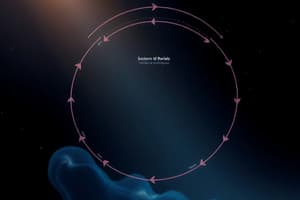Podcast
Questions and Answers
What is represented by the real flow in a circular flow diagram?
What is represented by the real flow in a circular flow diagram?
- The transfer of money in the economy
- The purchasing behavior of consumers
- The government's revenue from taxes
- The physical flow of resources and products (correct)
In a circular flow diagram, who provides the factors of production?
In a circular flow diagram, who provides the factors of production?
- The government
- The firms
- The foreign sector
- The households (correct)
What role does the product market play in the circular flow diagram?
What role does the product market play in the circular flow diagram?
- Households pay taxes to the government
- Households provide resources to firms
- Households buy goods and services from firms (correct)
- Firms sell factors of production to households
Which component is NOT typically included in the basic version of a circular flow diagram?
Which component is NOT typically included in the basic version of a circular flow diagram?
How does the government affect the flows in the circular flow diagram?
How does the government affect the flows in the circular flow diagram?
Which of the following is a limitation of the circular flow diagram?
Which of the following is a limitation of the circular flow diagram?
What does the monetary flow between households and firms represent?
What does the monetary flow between households and firms represent?
What does the foreign sector contribute to the circular flow of an economy?
What does the foreign sector contribute to the circular flow of an economy?
Flashcards are hidden until you start studying
Study Notes
Circular Flow Diagram
-
Definition: A circular flow diagram illustrates the flow of goods, services, and money in an economy between households and firms.
-
Key Components:
- Households:
- Consume goods and services.
- Provide factors of production (labor, land, capital).
- Firms:
- Produce goods and services.
- Hire factors of production from households.
- Households:
-
Flow Types:
- Real Flow:
- Represents physical flow of resources and products.
- Households provide resources to firms, firms deliver goods to households.
- Monetary Flow:
- Represents money movement within the economy.
- Firms pay households for resources, households spend money to purchase goods and services from firms.
- Real Flow:
-
Interactions:
- Product Market: Where goods and services are bought and sold; firms sell, households buy.
- Factor Market: Where factors of production are bought and sold; households sell, firms buy.
-
Government and International Sectors (expanded model):
- Government: Collects taxes and provides public goods/services; impacts flows by regulating or stimulating economic activity.
- Foreign Sector: Includes trade with other countries; exports and imports affect the flows between domestic households and firms and foreign economies.
-
Importance:
- Demonstrates interdependence in the economy.
- Useful for understanding economic concepts like GDP, inflation, and employment.
- Helps visualize the impact of policy changes on different sectors.
-
Assumptions:
- Economic agents act rationally.
- All activities occur within a closed economy without external influences (in simplified models).
-
Limitations:
- Oversimplifies the complexities of real economies.
- Doesn't include factors like savings, investments, or financial markets in its basic form.
-
Applications:
- Economic modeling and forecasting.
- Teaching tool for illustrating economic principles.
- Analyzing economic policies and their effects on different sectors.
Circular Flow Diagram
- Visual representation of the flow of resources, goods, services, and money between households and firms in an economy.
- Consists of two main flows:
- Real flow: Flow of physical resources (land, labor, capital) from households to firms, and the flow of goods and services from firms to households.
- Monetary flow: Flow of money from firms to households in exchange for resources, and from households to firms in exchange for goods and services.
- Two key markets:
- Product market: Where goods and services are bought and sold, firms are sellers, households are buyers.
- Factor market: Where factors of production (land, labor, capital) are bought and sold, households are sellers, firms are buyers.
- Can be expanded to include the government and foreign sector:
- Government: Collects taxes, provides public goods and services, influences flows through regulation and economic policies.
- Foreign sector: Represents trade with other countries, includes exports and imports, affects the flow between domestic and foreign households and firms.
- Demonstrates interdependence in the economy.
- Useful for understanding key economic concepts such as GDP, inflation, and employment.
- Helps visualize the impact of policy changes on different sectors.
Simplifying Assumptions
- Economic agents act rationally.
- The economy is closed, meaning there is no interaction with other economies.
- No inclusion of savings, investments, or financial markets in the basic model.
Limitations
- Oversimplifies the complexities of real economies.
- Doesn't account for factors such as savings, investments, and financial markets.
Applications
- Economic modeling and forecasting.
- Teaching tool for illustrating economic principles.
- Analyzing economic policies and their effects on different sectors.
Studying That Suits You
Use AI to generate personalized quizzes and flashcards to suit your learning preferences.



